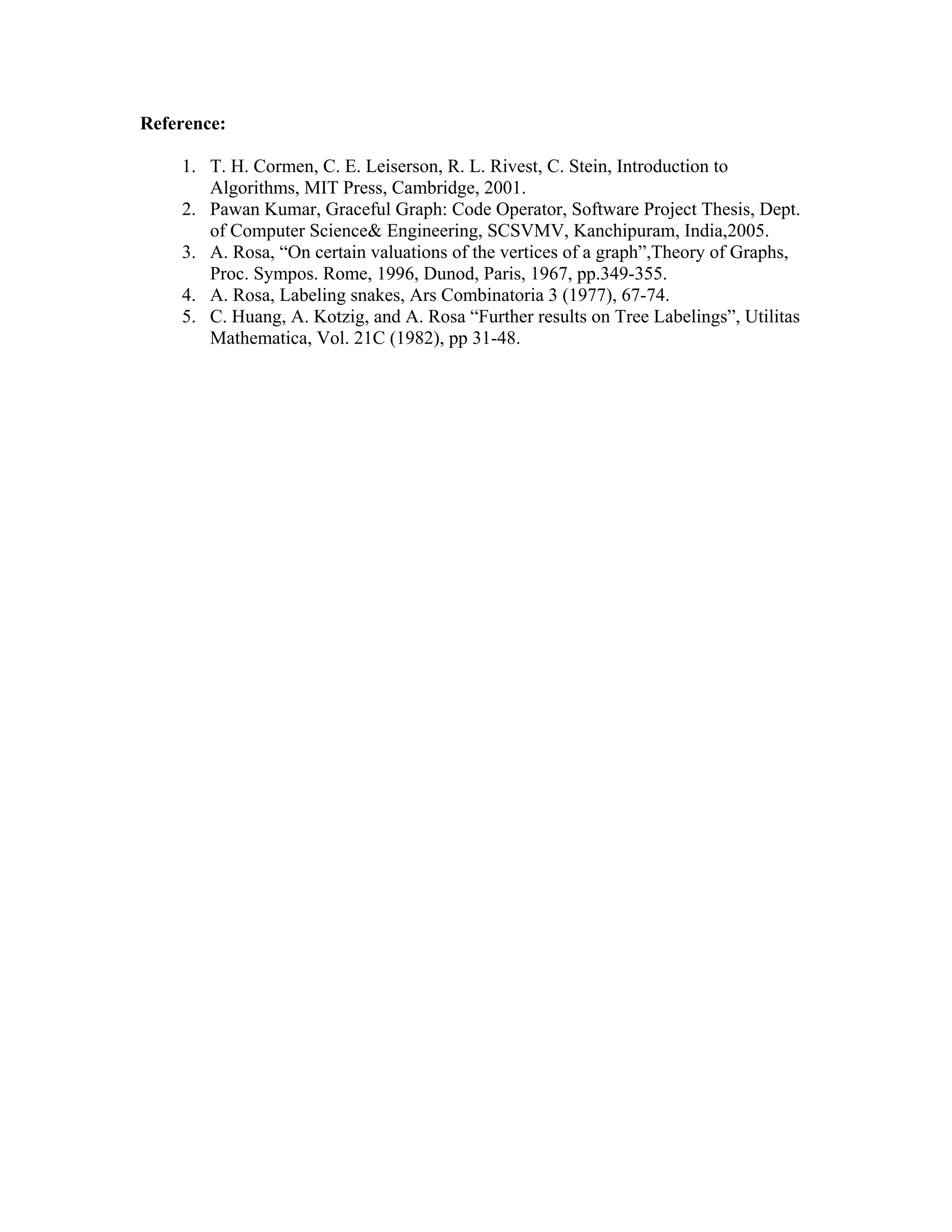This document presents algorithms for generating all possible tree codes (representations of trees as sequences of integers) for a given number of edges. It establishes several arithmetic properties of tree generation codes, including that adding certain integer sequences to existing tree codes will always produce new valid tree codes. Theorems are provided to construct tree codes by appending, repeating, or transforming parts of existing tree codes in ways that preserve the tree structure. An algorithm is also described for checking if a given graceful graph code represents a tree using the Prüfer code technique.
![Arithmetical properties of tree generation codes and algorithm to
generate all tree codes for a given number of edges
K. Balasubramaniana
, N. Chandramowliswaranb
, N. Ramachandranb
,
S. Arunc
, Pawan Kumarc
a
Department of Statistics , Indian Statistical Institute, New Delhi, India.
b
Department of Mathematics, Sri Chandrasekharendra Saraswathi Viswa Maha Vidyalaya,
Kanchipuram-631 561, India.
c
Department of Computer Science & Engineering, Sri Chandrasekharendra Saraswathi Viswa Maha
Vidyalaya, Kanchipuram, Kanchipuram-631 561, India.
Abstract:
Graceful Code is a way to represent graceful graph in terms of sequence of
non-negative integers. Given a graceful graph G on “q” edges, we can generate its
graceful code in the form of (a1, a2, a3, …, aq-1, aq) to represent the graph. Similarly, we
can easily draw the graph from the given graceful code.
In this paper, we present an algorithm to generate all possible tree codes on a
given number of edges (say q=30). Moreover, we also present the arithmetic properties of
tree generating codes and an algorithm to check whether the code of a given graceful
graph represents a tree or not. This algorithm uses prüfer code techniques on graceful
codes to perform tree checking. The prüfer technique of removing the lowest labeled leaf
easily determines the code to be a tree or not.
Keywords: Graceful graphs, Graceful codes, α-valuable codes.
Introduction:
Definition 1:
A Graceful labeling of a simple graph G with “q” edges is an injection “f ” from the
vertices of G to the set {0,1, 2, 3, …, q} such that the induced function g: E→{1, 2, …,q}
g (e) = | f(u) - f(v) | for every edge e ={u, v}, is a bijective function
A graph, which has a graceful labeling, is called a Graceful graph.
This labeling was originally introduced in 1967 by Rosa who has also showed that the
existence of a graceful labeling of a given graph G with “q” edges is a sufficient
condition for the existence of a cyclic decomposition of a complete graph of order
“2q+1” into sub-graphs isomorphic to G. [See Ref]. The famous Graceful Tree
Conjecture says that all trees have a graceful labeling.](https://image.slidesharecdn.com/d66c1a28-5fa3-4ce3-8295-c45fbb3e5407-150802174949-lva1-app6892/75/tree-gen-algo-1-2048.jpg)
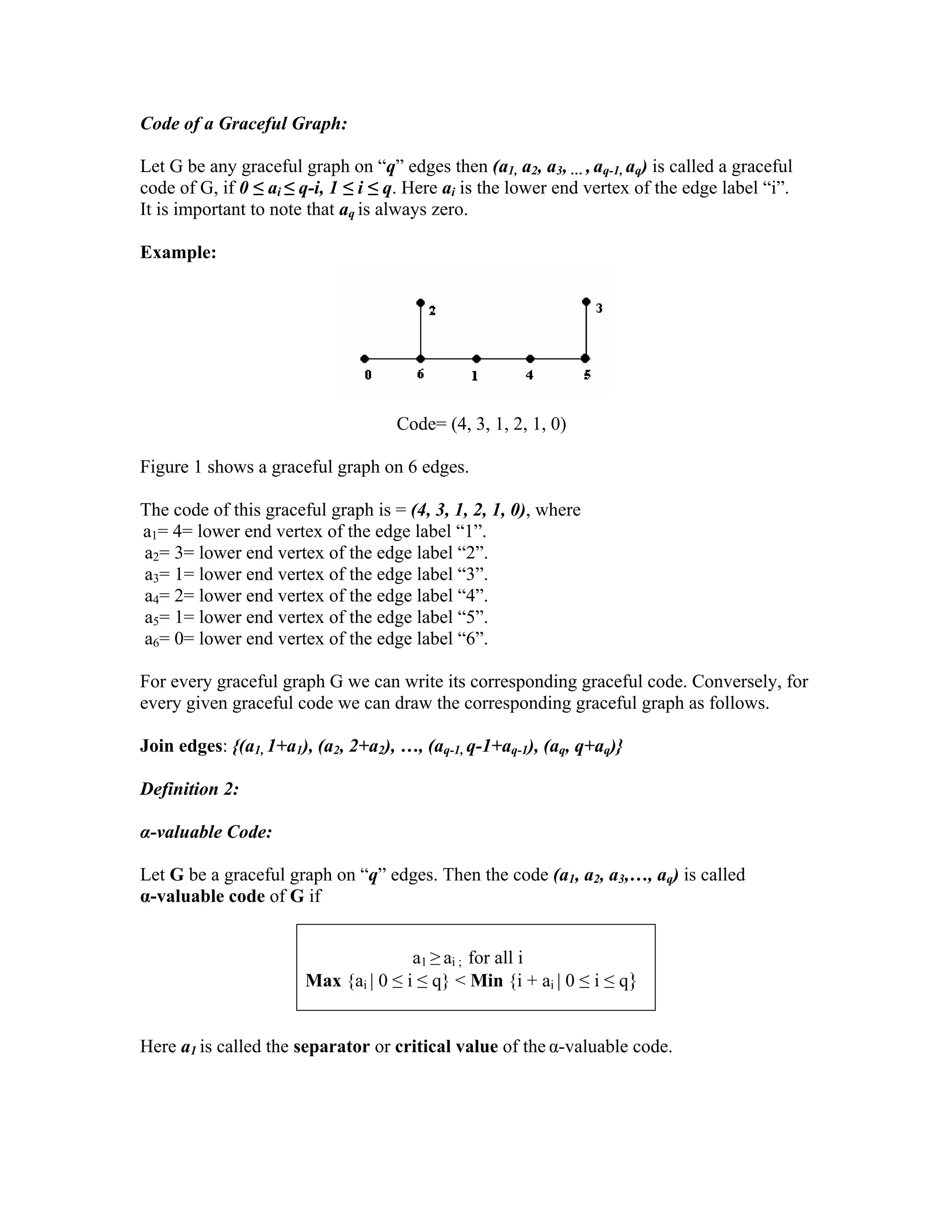
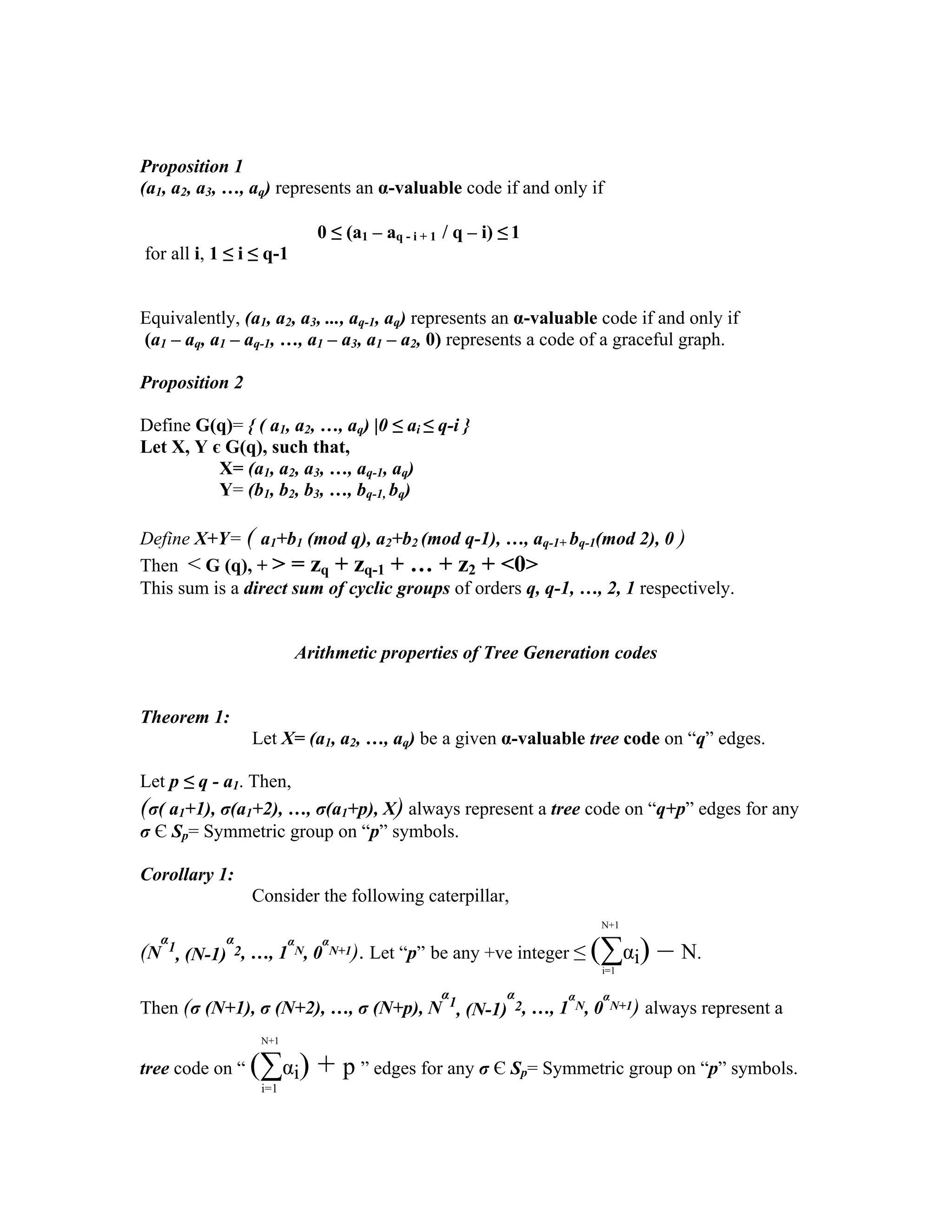
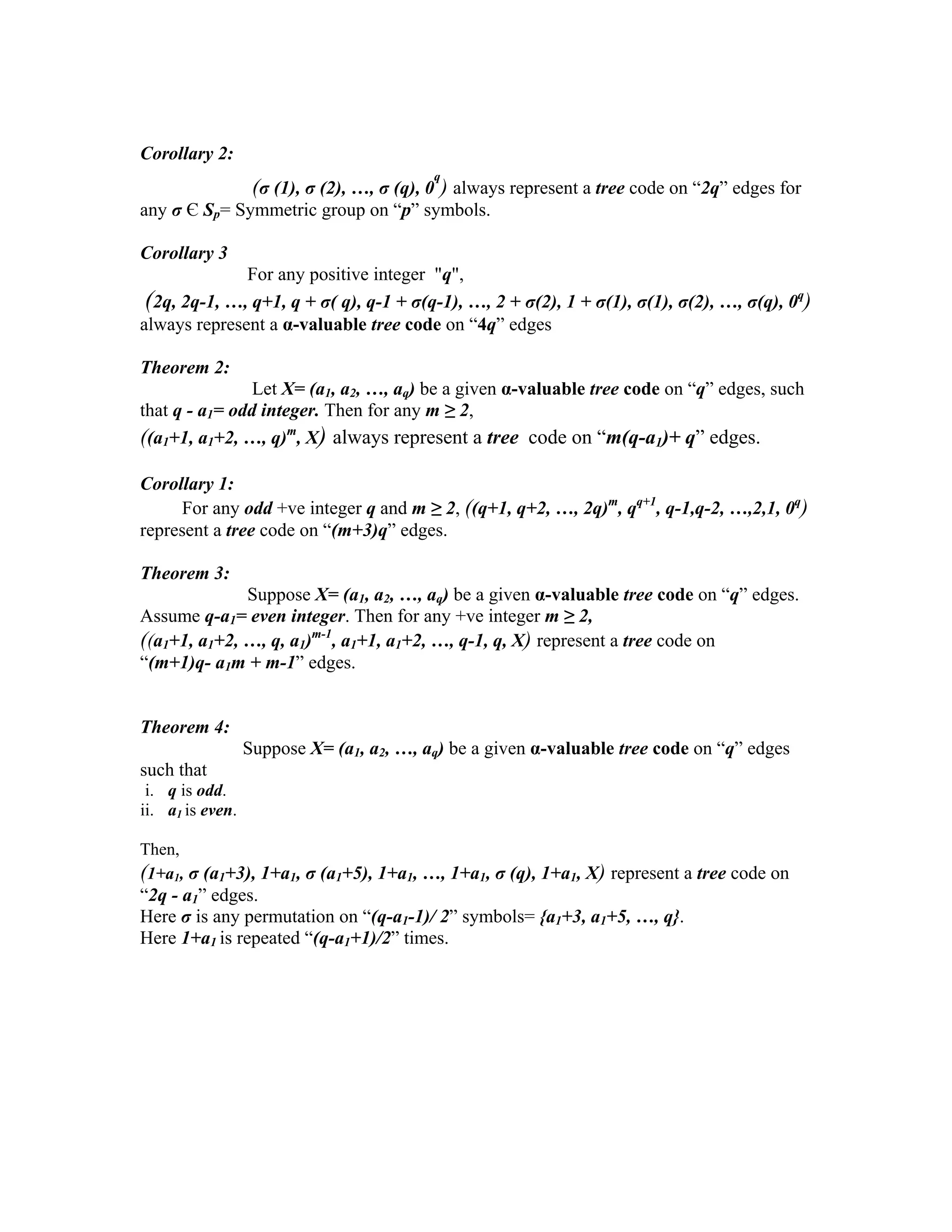
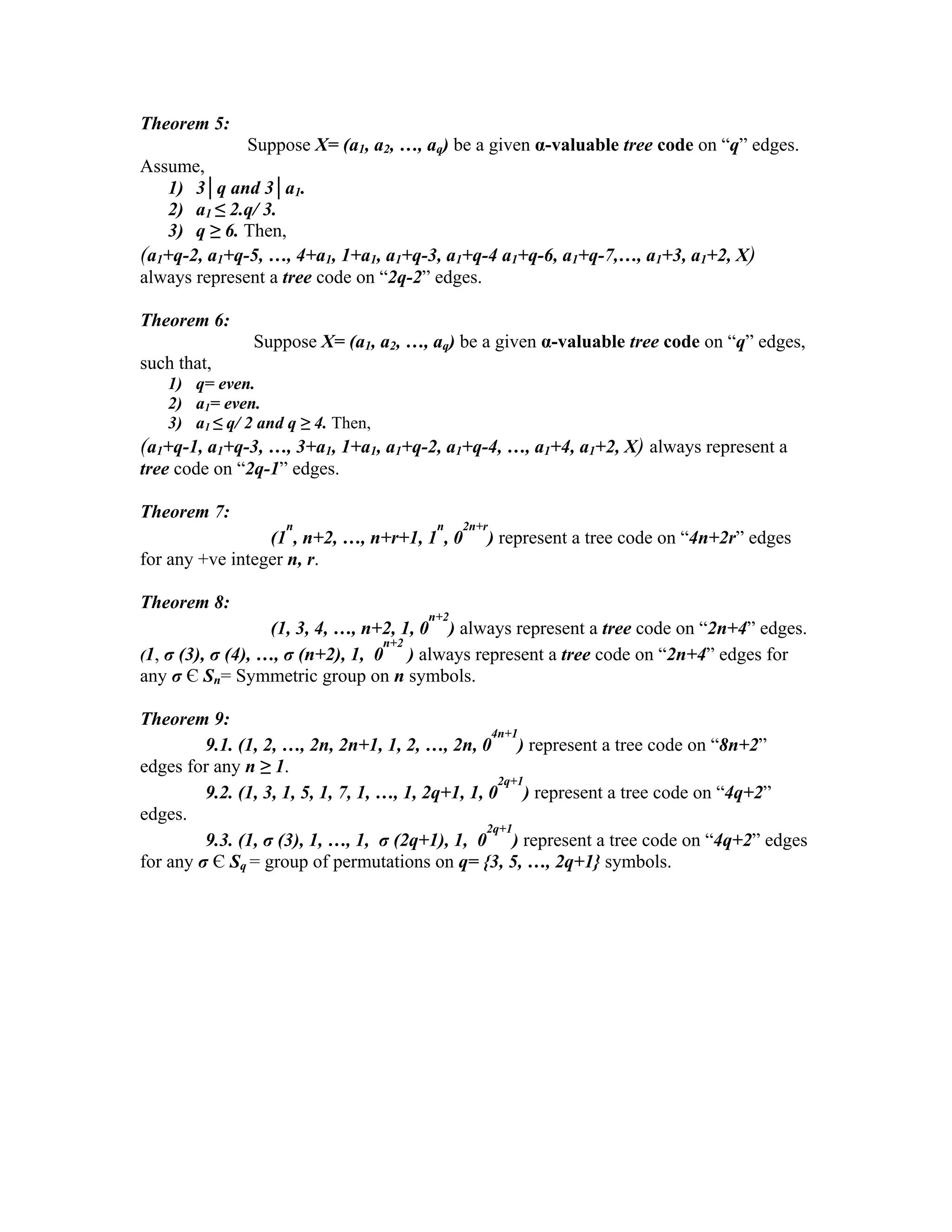
![Theorem
N+1
10:
Suppose (∑αi) – N = odd +ve integer, then for any +ve integer
i=1
m
N+1 N+1
≥ 2,
((N+1, N+2, …, (∑αi) – 1, ∑αi )
m
, N
α
1
, (N-1)
α
2, …, 1
α
N, 0
α
N+1) always
i=1 i=1
N+1 N+1
represent a tree code on “m[(∑αi) – N ] + ∑αi ” edges.
i=1 i=1
Theorem 11: N+1
Suppose (∑αi) – N = even +ve integer, then for any +ve integer
i=1
m ≥ 2,
N+1 N+1 N+1 N+1
((N+1, N+2, …, (∑αi) – 1, ∑αi , N)m-1
,N+1, N+2, …, (∑αi) – 1, ∑αi,
i=1 i=1 i=1 i=1
N
α
1
, (N-1)
α
2, …, 1
α
N, 0
α
N+1)
N+1
represent a tree code on “(m+1) (∑αi) – Nm+m-1” edges.
i=1
Theorem - 12
Suppose (a1, a2, …, aq-1, aq) represent a code of a graceful tree on “q” edges. Then
X = (aq+q, aq-1+q-1, …, 2+a2, 1+a1, x, a1, a2, a3……, aq-1, aq), [0≤x≤q] represent a
α–valuable tree code on “2q + 1” edges.
Define U(X)
= ( q + 1 + (aq , aq -1 , …, a2, a1) , x + q + 1 , q + 1 + (a1 + 1 , a2 + 2, …, aq + q ) )
U(X)R
q= ( q + 1 + (aq + q, aq-1 + q – 1, …, a2 + 2 , a1 + 1) , x + q+ 1,
q + 1 + (a1, a2, …, aq-1, aq ) ) )
Then
(U(X)R
+ (k – 2)q , q U(X)R
+ (k – 3)q , …, U(X)R
+ q , U(X)R
, X ) always
represent a α–valuable tree code on “2kq + k” edges (k ≥ 3) +== +
==========---ppp0000000iiiii ===[[[[](https://image.slidesharecdn.com/d66c1a28-5fa3-4ce3-8295-c45fbb3e5407-150802174949-lva1-app6892/75/tree-gen-algo-6-2048.jpg)
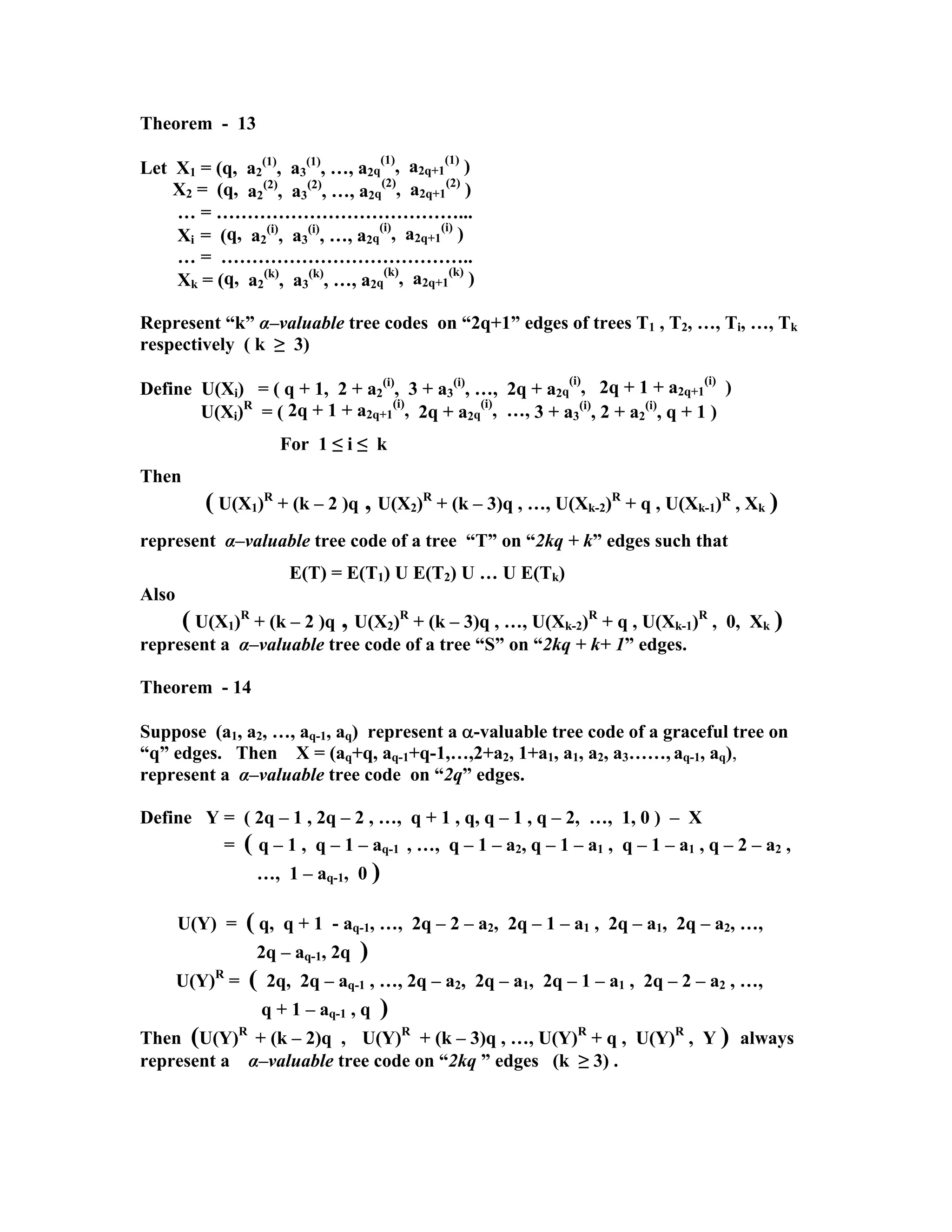
![Algorithm (Tree Check):
1. q← no. of edges in the graph.
2. q1← q
3. for i← 0 to q-1
4. // Get the code of graph
// Store it in a[0…. q-1]
5. for i← 0 to q-1
6. if (a[i] < 0 or a[i]> q-i-1)
7. // not a graceful code
8. exit
9. for i←1 to q
10. do b[i-1] = i+a [i-1]
11. // upper code stored in array b[]
12. for key←0 to q1
13. element ← 0
14. j← 0
15. while (j<q)
16. if (key= a[j] or key= b[j])
17. element← element +1
18. j← j+1
19. else
20. j← j+1
21. if (element=0)
22. code does not represent tree
23. exit
24. key← 0
26. while (key <=q1)
27. element← 0
28. j← 0
29. while (j<q)
30. if (key=a[j] or key=b[j])
31. element← element +1
32. j← j+1
33. else
34. j← j+1
35. key← key+1
36. if (element=1)
37. SEARCH (key-1)
38. if (z<2*q1)
39. code does not represent tree](https://image.slidesharecdn.com/d66c1a28-5fa3-4ce3-8295-c45fbb3e5407-150802174949-lva1-app6892/75/tree-gen-algo-8-2048.jpg)
![SEARCH (temp):
1. for n←0 to q-1
2. if (a[n]= temp or b[n]= temp)
3. TREEVERT (n)
4. VERDELETE (n, q)
5. key← 0
TREEVERT (d)
1. tree [z]←a[d]
2. z← z+1
3. tree [z]←b[d]
4. z← z+1
5. if (z=2*q1)
6. // code represents a tree
VERDELETE (n, k)
1. for x← n to k-2
2. a[x]← a[x+1]
3. b[x]← b[x+1]
4. k← k-1
5. q← k](https://image.slidesharecdn.com/d66c1a28-5fa3-4ce3-8295-c45fbb3e5407-150802174949-lva1-app6892/75/tree-gen-algo-9-2048.jpg)
